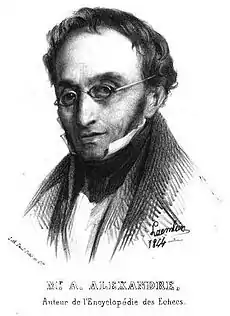Aaron Alexandre
Aaron (Albert) Alexandre (Hebrew: אהרון אלכסנדר, around 1765/68 in Hohenfeld, Franconia – 16 November 1850 in London, England) was a German–French–English chess player and writer.

Aaron Alexandre, a Bavarian trained as a rabbi, arrived in France in 1793.[1] Encouraged by the French Republic's policy of religious toleration, he became a French citizen. At first, he worked as a German teacher and as mechanical inventor. Eventually, chess became his primary occupation. He tried to make a complete survey of the chess openings, publishing his findings as the Encyclopédie des échecs (Encyclopedia of Chess, Paris, 1837). In this book, he used the algebraic notation and the castling symbols 0–0 and 0–0–0.[2][3] In 1838, he won a match against Howard Staunton in London, though before Staunton became a master.[4] Alexandre was one of operators of the fake chess-playing machine known as the Turk.[5]
See also
References
- Saint-Amant [Pierre-Charles Fournier de], Nécrologie: A. Alexandre, La Régence, 1st ser., 3, no. 1 (January 1851): 3–13.
- Knight's Tour Notes, Part Cb: Chronology 1800 – 1899
- Crescendo of the Virtuoso "ch1"
- David Hooper, Ken Whyld, The Oxford companion to chess (1984) page 326, and second edition p390.
- Tom Standage, The Turk: The Life and Times of the Famous Eighteenth-Century Chess-Playing Machine (New York: Walker, 2002), 206.